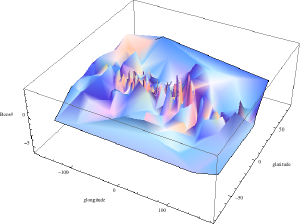Post
Cosmic Corn Syrup
12 March 2013
Yesterday I showed how you can use polarizing filters and corn syrup to demonstrate the rotation of polarized light. So what does corn syrup have to do with astrophysics?
It turns out that visible light isn’t the only thing that can be polarized. Radio waves can have polarization as well. It also happens that the radio pulses generated by pulsars can be polarized. That means we have lots of polarized radio sources throughout the galaxy.
Deep space in the galaxy is not entirely empty. There is a small amount of ionized gas (plasma) that exists between the stars. The radio signals from pulsars must therefore pass through this plasma to reach us. That means we can use pulsar signals to learn about the plasma between us and the pulsar.
By itself the plasma simply spreads out the signal by frequency. This is similar to the way glass spreads out a pulse of light by frequency. The speed of light passing through glass (or the index of refraction) is slightly different for each color, so the pulse is spread out a bit. For light and glass the effect is small, so we don’t normally notice it, however it’s this same effect that lets prisms break light into colors. For pulsar pulses and galactic plasma the effect is more dramatic. The radio pulse travels for light years, so there is much more time for it to spread by frequency. So instead of a simple radio pulse, we see the higher frequencies reach us a bit sooner than the lower frequencies. This spread is known as the dispersion measure (DM), and it depends on the amount plasma between the radio source and us. So the DM of radio signals lets us determine how much ionized gas there is in the galaxy.
 Brian Koberlein
Brian KoberleinWhen there is a magnetic field present in the plasma the radio pulses not only spread by frequency, but their polarization rotates by frequency. Just like the corn syrup, a magnetized plasma rotates polarized radio signals by frequency. This twisting of the polarization is known as the rotation measure (RM). The RM of a radio pulse depends on the amount of plasma between us and the radio source (which we know through the DM) and the strength of the magnetic field. So by measuring the DM and RM of a polarized pulsar signal, we can determine the strength of the magnetic field.
There are lots of pulsars through our Milky Way Galaxy. By observing the DM and RM of these pulsars we can create a map of the magnetic field within our galaxy. The result can be seen in the figure below. You can see the magnetic field isn’t uniform, but has strong regions and weak regions.
So even though we can’t see the galactic magnetic field directly, we know what it looks like. Just by using cosmic corn syrup and polarized light.